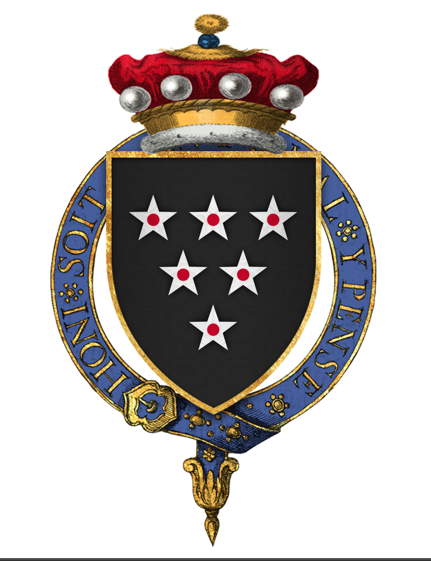|
| Margaret Grey (c.1397-c.1426) |
|
 Arms of Bonville: Sable, six mullets argent pierced gules |
17GGM Margaret Grey, born c.1397 in Ruthin Castle, Denbighshire, Wales, fifth child and third daughter of 18GGP Lord Reynold Grey, 3rd Baron Grey de Ruthyn and Margaret de Ros. She married 17GGF Lord William Bonville; their daughter 16GGM Elizabeth Bonville (died 14 February 1491), married 16GGF Sir William Tailboys, by whom she had at least one son, 15GGF Sir Robert Tailboys (1451–1495).
Grandpa Lord William was an English nobleman and an important, powerful landowner in southwest England during the Late Middle Ages. his father died before Bonville reached adulthood. As a result, he grew up in the household of his grandfather and namesake, who was a prominent member of the Devon gentry. Both his father and grandfather had been successful in politics and land acquisition, and when Bonville came of age, he gained control of a large estate. He augmented this further by a series of lawsuits against his stepfather, Richard Stucley. |
|
Bonville undertook royal service, which then meant fighting in France in the later years of the Hundred Years' War. In 1415, he joined the English invasion of France in the retinue of Thomas, Duke of Clarence, Henry V's brother, and fought in the Agincourt campaign. Throughout his life, Bonville was despatched on further operations in France, but increasingly events in the southwest of England took up more of his time and energy, as he became involved in a feud with his powerful neighbour Thomas Courtenay, Earl of Devon.
In 1437, King Henry VI granted Bonville the profitable office of steward of the Duchy of Cornwall. This had traditionally been a hereditary office of the earls of Devon, and the Earl was enraged at its loss. The dispute soon descended into violence, and Bonville and Courtenay ravaged each other's properties. The situation was exacerbated in 1442 when the Crown appointed Courtenay to effectively the same stewardship it had appointed Bonville, which inflamed the situation even more. The feud between them continued intermittently for the next decade. Generally, Henry and his government failed to intervene between the two parties; when it did, its efforts were ineffectual. On one occasion Bonville was persuaded to undertake further service in France—primarily to get Bonville out of the region—but the mission was poorly funded, a military failure, and when Bonville returned the feud reignited. In 1453, King Henry became ill and entered a catatonic state for eighteen months, heightening the political factionalism that had riven his reign. Bonville generally seems to have remained loyal to the king, although his guiding motivation was to support whoever would aid him in his struggle against Courtenay. Their feud was part of a broader breakdown in law and order which eventually evolved into the Wars of the Roses in 1455. Bonville seems to have managed to avoid implication in the variable swings in political fortune which followed until 1460. At this point, he threw in his lot with the rebellious Richard, Duke of York. His new allegiance brought him little profit; his son was killed alongside York at the Battle of Wakefield in December 1460, while Bonville himself took part in the Second Battle of St Albans two months later on the losing side; with the new Earl of Devon watching, he was beheaded on 18 February 1461. |
|
Back a Page (Margaret de Ros) |
This
Section: Carlisle |
Page Index Homesteads Ancestors |
[MargaretG.htm] Updated Jul 2020 |
Next Page (Elizabeth Bonville) |
Page 114 |
| Welcome | Stories | Sections | Such a Life | People | Places | Site Search | Do You Know? |